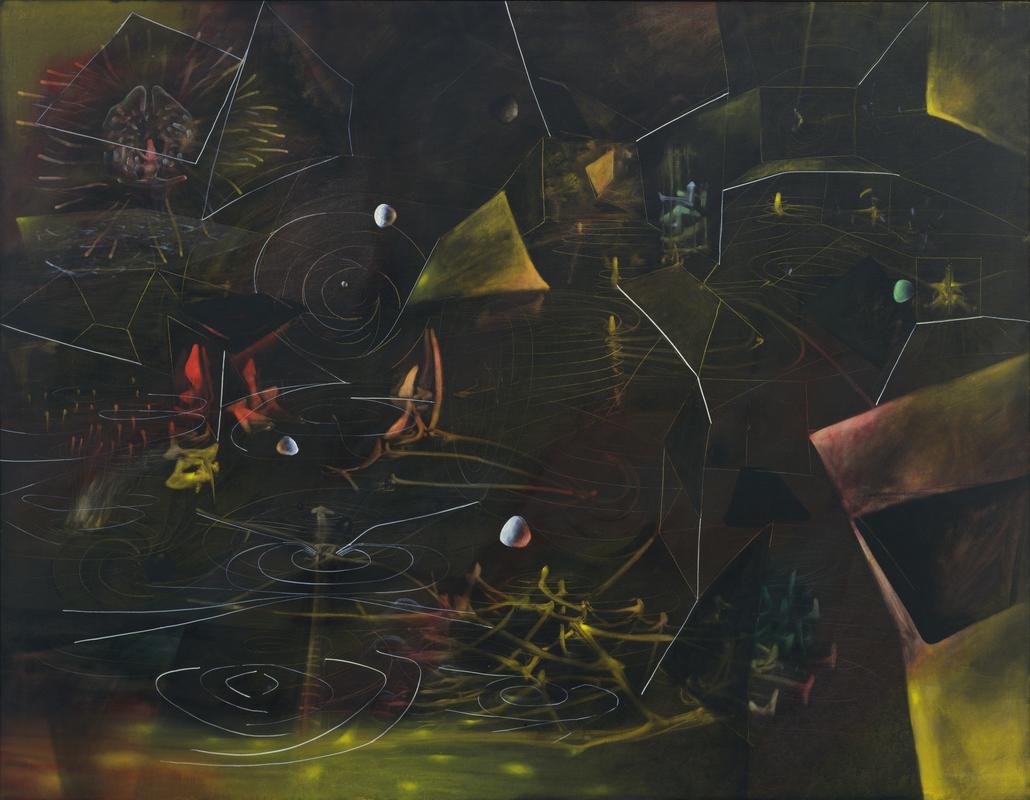More about The Vertigo of Eros

Contributor
Roberto Matta’s The Vertigo of Eros embodies the Surrealist movement's shared goal to delve into the depths of the mind and extract the secrets of the subconscious.
This “psychological morphology,” or inscape visually represents the internal landscape, meshing the psychic with the physical. Matta paints the vision behind closed eyes by externalizing the patterns and geometric shapes you see after rubbing your eyes. Rather than depicting the physical world, Matta depicts the residual images not from the external world, but illusions that originate in the mind’s eye.
Unless you have a fair amount of knowledge of the Surrealist movement, it can be difficult to decipher what may be considered “Surrealist” based on looking at an artwork alone. Most movements prior to Surrealism categorized themselves based on aesthetic or technique. Surrealism, on the other hand, is bound solely by conceptual similarities. Two fundamental ideas tie the Surrealist movement together: automatism and formlessness. Automatism is when an artist endeavors to let go of conscious control over the artmaking process, instead allowing the unconscious mind to guide them. Formlessness is about allowing art to be nonrepresentational, as well as a signifier of the futility of trying to pin down the universe into so-called "forms". The concept was introduced by French philosopher Georges Bataille, so the definition is somewhat confusing and formless itself (you know how those philosophers like to make things hard).
If all of this conceptual crap gives you vertigo, then simply appreciate the aesthetic appeal of the work. When confronted by a Matta painting in a gallery, it immediately catches your eye. Even someone without a lot of knowledge of art history can appreciate the familiar quality of a Matta painting, but it’s a familiarity that you can’t quite place upon an initial glance. But when you close your eyes and succumb to the visions that appear on their own, you begin to understand how Matta captures the landscape of the mind. He achieves this primarily by layering paint on top of itself, then scraping it away with a palette knife. The spermatic lines paired with white egg-like orbs that result from this process cover the canvas like the origins of life itself, the basic integers that lie beneath all human consciousness.
The original French title Le Vertige d’Eros pronounced phonetically sounds like “Les Vertes Tiges des Roses” or “The Green Stalks of Roses,” suggesting the metamorphosis of a plant from fertilization to plant to flower to fruit. This title references Bataille’s “The Language of Flowers,” in which he describes the ever-changing appearance of flowers. We associate flowers with ideal beauty, but “even the most beautiful flowers are spoiled in their centers by hairy sexual organs.” The leafy stalks rise up like erections towards the sky with the effeminate corolla situated atop, both feminine and masculine in nature. The flower is the first part of the plant to rot and stink, suggesting that “desire has nothing to do with ideal beauty.” The process of the flowers’ transformation from a representation of ideal beauty to rottenness symbolizes the swirling metamorphosis of love, the vertigo of eros.
Matta aimed to paint the whole universe at once. Conception, gestation, birth, life, death. The microscopic and the macroscopic. The universal and the infinitesimal. The inner and outer worlds. The Vertigo of Eros contains a metaphor of infinite space swirling endlessly like both the cosmos and the space of the mind. Inscapes, then, depict the limits of the human experience: we are slaves to the architecture of our mind and our sexual drive. By transcending reality, Matta’s depictions embody Surrealism: going beyond reality to explore the depths of human consciousness and its relationship to the universe at large.
Sources
- Batailles, Georges. “Formless.” In Visions of Excess: Selected Writings, 1927-1939. University of Minnesota Press, 1985.
- Batailles, Georges. “The Language of Flowers” In Visions of Excess: Selected Writings, 1927-1939. University of Minnesota Press, 1985.
- Goizueta, Elizabeth. “The Artist as Poet: Symbiosis between Narrative and Art in the Work of Matta.” In Matta: making the Visible Invisible. University of Chicago Press, 2004.
- Smith, Elizabeth A. T., Colette Dartnall, and William Rubin. Matta in America: paintings and drawings of the 1940s. Chicago: Museum of Contemporary Art, 2003.











